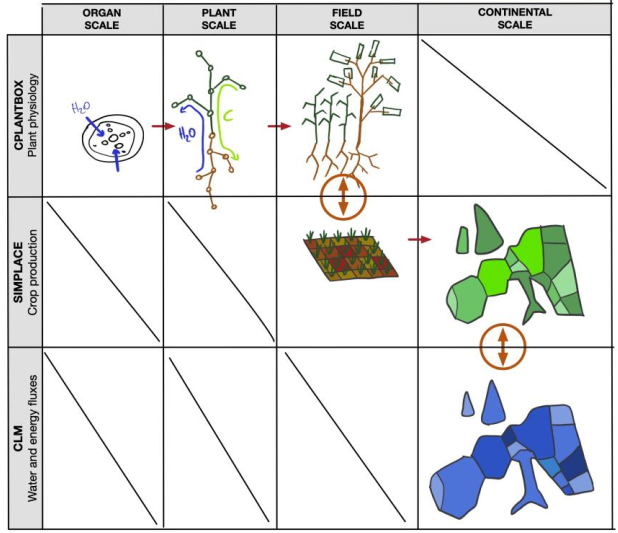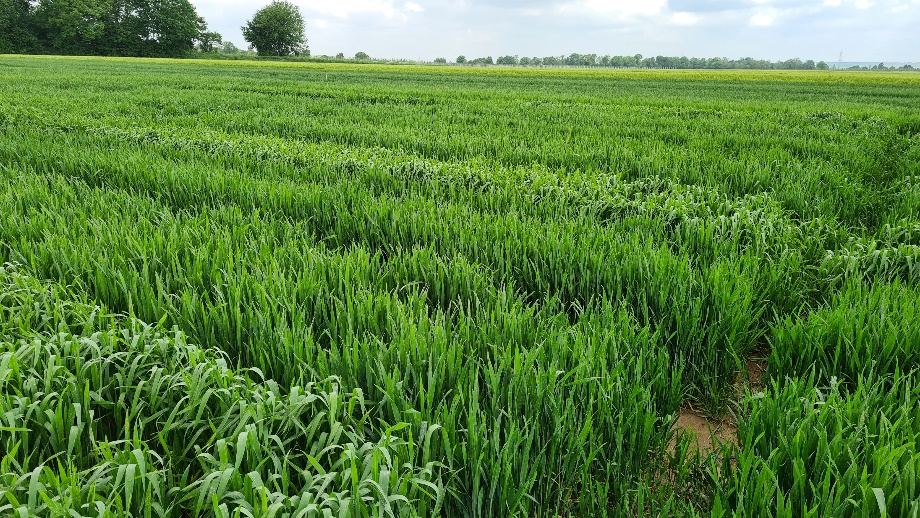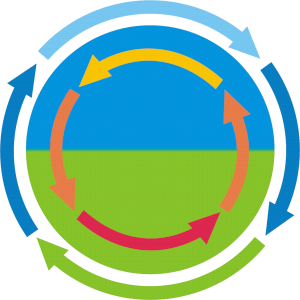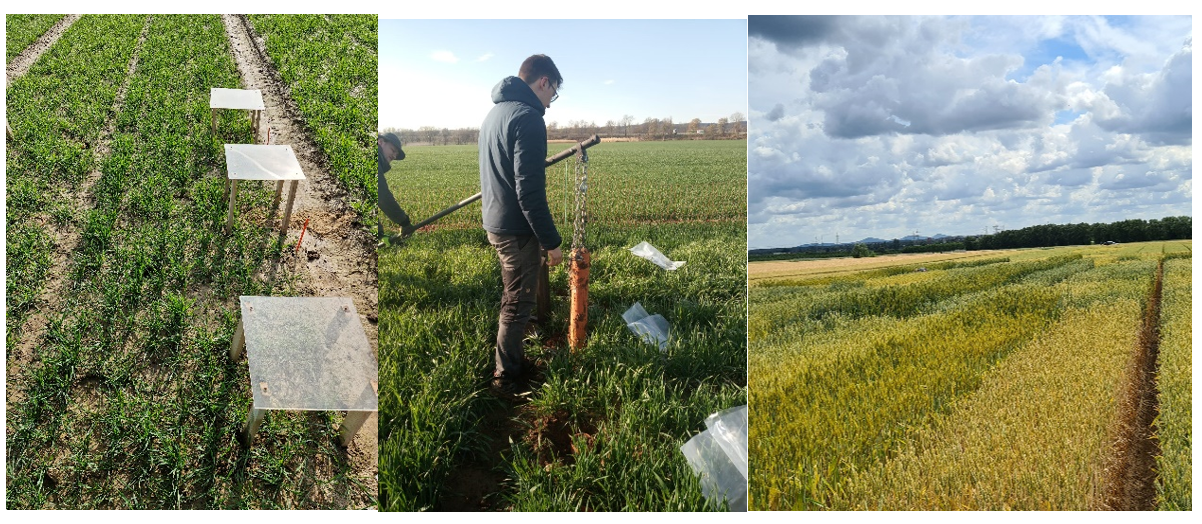C02
Modulation of soil water fluxes by changes in vegetation properties and management
Prof. Dr. Frank Ewert
University of Bonn | +49 228 73-2041 |
Dr. Thomas Gaiser
University of Bonn | +49 228 73-2050 |
Prof. Dr. Guillaume Lobet
Forschungszentrum Jülich | +49 2461 61-9013 |
Summary
We will investigate the impact of changes in agricultural and forest management during the last decades on land surface – atmosphere interactions. We will improve the parameterization of land surface model CLM so that it can reproduce the effects of changes in management on regional heat, water and carbon fluxes. Therefore, we will link a suite of models starting from mechanistic single plant models that couple carbon and water flow within the plant with the external environment over specific crop models at the field scale to the Community Earth System Model CLM.
Graphical summary

Contribution to the CRC
Our project will closely collaborate with C03, where maps of CLM 5.0 ecosystem parameters for different plant functional types (PFTs) will be estimated from observations; results will be compared and used to validate our bottom-up approach and will provide mechanistic approaches for improving the carbon partitioning in CLM 5.0. We will also closely collaborate with D03 in a bottom-up forest representation in CLM and with B05 in the development of crop-specific irrigation timeseries. Also, the results of our simulations regarding potential yields under optimum water and nutrient supply for specific crops in historical periods will serve as an input for project A05.
Approach
The central hypothesis of this project is that changes in agricultural and forest management during the last decades have had strong impacts on land surface-atmosphere interactions and therefore need to be accounted for in land surface models. To test this hypothesis, we will use the mechanistic whole-plant model CPlantBox, to simulate water and carbon fluxes at plant and field scale and evaluate the interactions between crop development, climate, and management that emerge. The results obtained from the simulations with CPlantBox will be used to parameterize the field-scale crop model SIMPLACE <LintulCC2>, first on the field scale and later the continental scale. SIMPLACE <LintulCC2> will further be used to estimate agricultural management and plant phenology parameters. Results from the plant and field scale models will be used to assess whether CLM can represent the effect of the emerging water and carbon interactions on crop development accurately. Finally, using the newly developed upscaling approach we will integrate an explicit representation of carbon and water fluxes into CLM and perform multi-annual simulations at continental scale.
The data needed to parametrize, calibrate, and validate the models across scales will be obtained from a literature review on root hydraulics, a long-term experiment with rotating crops and varying cultivars and timeseries from sites where carbon and water fluxes and crop development are measured across Europe (TERENO and FluxNet). To complete these calibration data sets, we are conducting two field experiment with wheat and rye cultivars from different decades, to investigate changes in canopy structure, assimilate partitioning between above and below ground plant parts and the impacts of stress factors like water stress on crop growth and assimilate partitioning.
Main results in 2022
A database on root hydraulic properties was developed, based on an extensive literature review of experimental studies of root-segments, individual roots, and whole root systems. The database will be used to improve the parameterization of the root water uptake model for different plant functional types, across scales.
Setup of the field experiment at the experimental research station of the University of Bonn, Campus Klein-Altendorf

Main results in 2023
Results of the first experimental year were obtained and the second year of the field experiment was set up. Meanwhile first test simulations with newly developed routines are conducted.
Publications:
- A sensitivity analysis of the crop model SIMPLACE<LintulCC2> was presented at the DBG annual meeting (https://www.dbg2023.de/assets/dgb-2023-abstractband-2023-08-17.pdf),
- A paper about combining root and soil hydraulics in macroscopic representations of root water uptake was published in the vadose zone journal (https://doi.org/10.1002/vzj2.20273)
Main results in 2024
The field experiment is in its last year and publications of the experimental data and first combined simulation exercises are being prepared.
First results from the field experiment and a new routine for the simulation of carbon partitioning in crops were presented as a poster at the EGU2024 (https://doi.org/10.5194/egusphere-egu24-16031)
The methodology developed in the field experiment was presented at the conference of the International Society of Root Research (https://www.12-isrr-2024.de/assets/isrr2024----book-of-abstracts-2024-06-13.pdf), winning a poster award (https://www.12-isrr-2024.de/award-winners.html)
First results of root architectural differences between the cultivars investigated in the experiment were presented at the EGU 2024 (https://doi.org/10.5194/egusphere-egu24-7991).
The database on root hydraulic properties is available and can be accessed through a user-friendly app: https://roothydraulic-properties.shinyapps.io/database/. The data can also be accessed via the DETECT GeoNetwork: https://detect-z03.geoinformation.net/geonetwork/srv/eng/catalog.search#/metadata/7252cbc3-13df-4505-93da-f16306c5e392
Publications:
Baca Cabrera, J.C. et al., 2024. Root hydraulic properties: An exploration of their variability across scales. Plant Direct, https://doi.org/10.1002/pld3.582
Nguyen, T.H. et al., 2024. Responses of field-grown maize to different soil types, water regimes, and contrasting vapor pressure deficit. Biogeosciences, https://doi.org/10.5194/bg-21-5495-2024
Vanderborght J. et al., 2024a. Combining root and soil hydraulics in macroscopic representations of root water uptake. Vadose Zone Journal, https://doi.org/10.1002/vzj2.20333
Vanderborght J. et al., 2024b. Mechanistically derived macroscopic root water uptake functions: The α and ω of root water uptake functions. Vadose Zone Journal https://doi.org/10.1002/vzj2.20333
Main results in 2025
The field experiment has been completed, and the results have either been published or publications are submitted and under revision.
Simulations at the European scale with SIMPLACE and eCLM are ongoing, focusing on the effects of crop varieties, phenology, and root and plant hydraulics on vegetation water and carbon fluxes.
Preliminary results on the significance of plant hydraulics for carbon and water fluxes in eCLM were presented as a poster at EGU 2025 (https://doi.org/10.5194/egusphere-egu25-6021)
Upcoming presentation at the European Plant Phenomics Symposium: “Phenotyping root anatomical and hydraulics traits in wheat: effects of breeding history and spatial gradients along the root”
Publications:
Baca Cabrera, J.C. et al., 2025. Decreased root hydraulic traits in German winter wheat cultivars over 100 years of breeding. Plant Physiology, https://doi.org/10.1093/plphys/kiaf166
Behrend, D. et al., 2025. Do biopores created by perennial fodder crops improve the growth of subsequent annual crops? A synthesis of multiple field experiments. Field Crops Research, https://doi.org/10.1016/j.fcr.2024.109687


